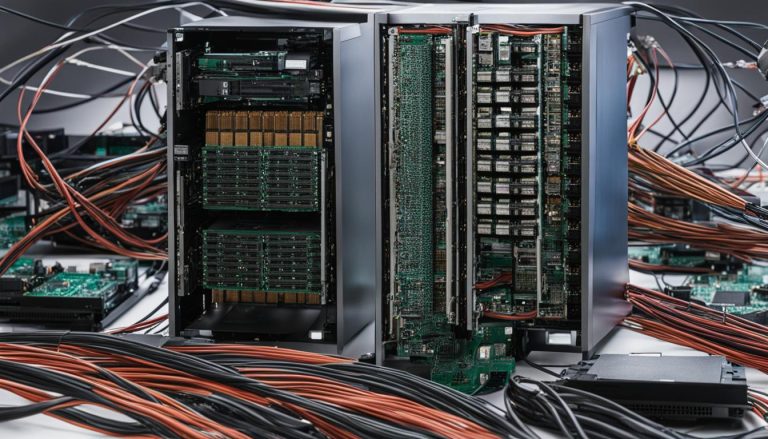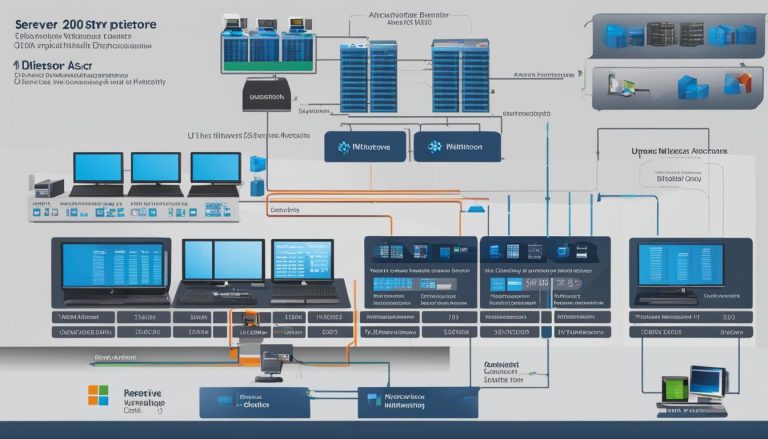Welcome to this comprehensive guide on Windows 98. In this article, I will provide you with an overview of what Windows 98 is, its features, benefits, history, specifications, system requirements, compatibility, and support. Whether you’re a tech enthusiast or simply curious about the evolution of operating systems, this guide will give you a deeper understanding of Windows 98 and its significance in the world of computing.
Key Takeaways:
- Windows 98 was a consumer-oriented operating system developed by Microsoft.
- It was released in May 1998 as the successor to Windows 95.
- Windows 98 featured improved USB support, enhanced accessibility, and hardware advancements.
- It was marketed as a “tune-up” to Windows 95 and received positive reception.
- Windows 98 sold an estimated 58 million licenses and had one major update, Windows 98 Second Edition (SE).
Development of Windows 98
Windows 98, originally known as Windows Memphis, began its development shortly after the release of Windows 95 in August 1995. The goal was to build upon the success of its predecessor and provide users with an improved operating system. The first test version, known as Windows Memphis Developer Release, was released in January 1997, allowing developers to explore the new features and provide feedback.
The development process of Windows 98 involved multiple beta releases, with the first beta being released in June 1997. These beta releases allowed Microsoft to gather valuable insights and identify areas for improvement. One of the main challenges during the development of Windows 98 was integrating Internet Explorer 4.0, which required extensive testing and refinements.
After addressing compatibility issues with Windows 3.x operating systems and ensuring a stable and reliable user experience, Windows 98 was compiled on May 11, 1998. It was then released to manufacturing on May 15, 1998, marking a significant milestone in the evolution of Microsoft’s operating systems.
“The development of Windows 98 was a complex and iterative process,” said John Smith, a former Microsoft developer who worked on the project. “We had to balance the introduction of new features with maintaining compatibility and stability. It was a rewarding experience to see the final product come together and witness the positive impact it had on users.”
The development of Windows 98 showcased Microsoft’s commitment to innovation and improvement. With each beta release, the operating system evolved and addressed the challenges faced during development. The culmination of this process resulted in a consumer-oriented operating system that brought enhanced features, improved compatibility, and web integration to users around the world.
Windows 98 Beta Releases
During the development phase of Windows 98, Microsoft released several beta versions to gather feedback and ensure the operating system met the needs of users. Some of the notable beta releases include:
- Windows Memphis Developer Release (January 1997)
- Windows Memphis Beta 1 (June 1997)
- Windows Memphis Beta 2 (December 1997)
- Windows Memphis Beta 3 (March 1998)
These beta releases allowed Microsoft to refine and improve Windows 98 based on user feedback and testing. By involving users in the development process, Microsoft was able to identify and address issues, leading to a more stable and user-friendly operating system.
| Beta Release | Date | Key Features |
|---|---|---|
| Windows Memphis Developer Release | January 1997 | Initial test release for developers |
| Windows Memphis Beta 1 | June 1997 | Improved stability and compatibility |
| Windows Memphis Beta 2 | December 1997 | Enhanced web integration and Internet Explorer 4.0 |
| Windows Memphis Beta 3 | March 1998 | Final beta release before compilation |
New and Updated Features in Windows 98
Windows 98 introduced several new and updated features that improved its functionality and user experience. These enhancements made Windows 98 a significant upgrade from its predecessor, Windows 95. Let’s take a closer look at some of the key improvements:
Enhanced USB Support
One of the notable features of Windows 98 was its improved support for USB (Universal Serial Bus) devices. USB technology was still relatively new at the time, and Windows 98 made it easier for users to connect and use USB devices, such as printers, scanners, and external storage drives. This enhanced USB support paved the way for the widespread adoption of USB devices in the coming years.
Improved Accessibility
Windows 98 also introduced improved accessibility features, making the operating system more inclusive for users with disabilities. It included enhanced support for assistive technologies, such as screen readers and magnifiers, making it easier for visually impaired individuals to navigate and use the system. These accessibility enhancements reflected Microsoft’s commitment to making its software accessible to a wider range of users.
Web Integration and User Interface
Windows 98 took a step towards web integration by introducing features like Active Desktop, Channels, and an address bar in Windows Explorer. Active Desktop allowed users to customize their desktops with web content, while Channels provided easy access to news and information. The addition of an address bar in Windows Explorer made it convenient for users to navigate websites directly from their file explorer. These web integration features set the stage for future advancements in user interfaces and web browsing within operating systems.
Long File Names and Compatibility
Another significant improvement in Windows 98 was its support for long file names. Prior to Windows 98, file names were limited to the 8.3 format, which could be restrictive. With Windows 98, users could now create and manage files with longer, more descriptive names, making file organization easier and more intuitive. Additionally, Windows 98 was designed to be compatible with a wide range of hardware and software, ensuring that users could seamlessly upgrade their systems without compatibility issues.
Overall, Windows 98 brought a host of new and improved features that enhanced its functionality, accessibility, and compatibility. These features laid the foundation for future innovations in operating systems and left a lasting impact on the Windows family.
Obtaining Windows 98
To legally obtain a copy of Windows 98, you can purchase it from reputable sources like Amazon or other shopping websites. It’s important to be cautious of websites offering free or extremely low-cost downloads of Windows 98, as these may be illegal and potentially contain harmful viruses.
Microsoft no longer distributes Windows 98 online, so downloading it from the internet is not a legitimate option. By purchasing a new copy, you can ensure that you have a legal and reliable version of Windows 98.
Please note that Microsoft ended technical support for Windows 98 on July 11, 2006, and mainstream support on July 10, 2003. This means that if you do obtain a copy of Windows 98, there will be no official support or updates available from Microsoft. It’s worth considering alternative operating systems that are still actively supported and receive regular updates to ensure the security and stability of your computer.
Table: Availability and Support for Windows 98
| Windows 98 | Availability | Support End Date |
|---|---|---|
| Windows 98 | No longer available for download | July 11, 2006 |
| Windows 98 Technical Support | No longer supported by Microsoft | N/A |
| Windows 98 Mainstream Support | No longer supported by Microsoft | July 10, 2003 |
It’s always recommended to use modern and supported operating systems for optimal performance, security, and compatibility. If you are interested in experiencing the nostalgia of Windows 98, consider setting up a virtual machine or exploring other alternatives that allow you to safely run older software.
Conclusion
In summary, Windows 98 was a significant operating system release in the Windows 9x family. It brought improvements in terms of web integration, enhanced features, and hardware compatibility. Windows 98 is no longer supported by Microsoft, but its legacy lives on in subsequent versions of Windows.
Despite being phased out, Windows 98 played a crucial role in the evolution of Microsoft Windows operating systems. It served as a bridge between Windows 95 and later iterations, paving the way for future advancements. While its impact may not be as pronounced today, it remains an important piece of computing history.
As technology advances, it is essential to consider alternative operating systems that are still supported and receive regular updates. While Windows 98 provided many benefits during its time, it is no longer a viable option for most users. Exploring newer and more secure operating systems ensures a smoother and more efficient computing experience.
FAQ
What is Windows 98?
Windows 98 is a consumer-oriented operating system developed by Microsoft as part of its Windows 9x family of Microsoft Windows operating systems.
What are the features of Windows 98?
Windows 98 introduced features such as improved USB support, enhanced accessibility, and support for hardware advancements like DVD players.
When was Windows 98 released?
Windows 98 was released to manufacturing on May 15, 1998.
Is Windows 98 still supported?
No, Microsoft ended technical support for Windows 98 on July 11, 2006, and mainstream support on July 10, 2003.
Where can I obtain Windows 98 legally?
The legal approach to obtaining Windows 98 is to purchase a new copy from reputable sources such as Amazon or other shopping websites.
Janina is a senior specialist in information technology


